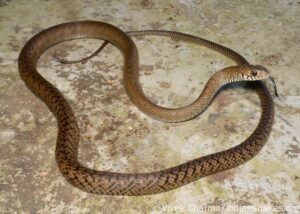Prelims Bits

Context
The Kerala government is evaluating a proposal to declare the Indian Rat Snake—locally called Chera—as the state’s official reptile.
General Information
- Common Names: Also referred to as the Oriental Rat Snake, this species is non-venomous.
- Geographic Range: Found across a broad region including India, Afghanistan, Pakistan, Bangladesh, China, Cambodia, Indonesia, Vietnam, and several other South and Southeast Asian nations.
- Habitat: This snake thrives in a wide range of environments such as forests, cleared areas, tropical dry forests, scrublands, plantations, and savannas.
Physical and Biological Features
- Size: Adult snakes typically measure 1.5 to 2 metres in length.
- Appearance: Their coloration varies, from light brown shades to almost black, depending on the region.
- Diet: A carnivorous predator, it primarily feeds on rats and rodents, but also consumes birds, frogs, lizards, and even other snakes.
Ecological Role and Significance
- Rodent Control: Due to its diet, the rat snake is vital in regulating the rodent population, benefiting agriculture. This earns it the title of “farmer’s friend.”
Conservation Status
- IUCN Red List: Listed as Least Concern (LC) due to its wide distribution and adaptability.
- Indian Wildlife Protection Act (WPA): Placed under Schedule I, providing it with the highest level of legal protection.
Threats
- Exploitation: The species faces pressure from illegal trade for its skin, meat, and traditional medicine uses.




